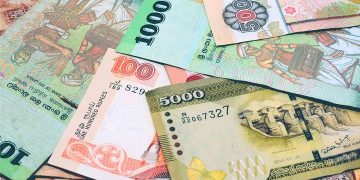By P.K.Balachandran/www.newsexpress.lk
Colombo, April 7: The prospect of signing a Sino-Sri Lankan agreement on the Hambantota port any time soon, has receded further with Prime Minister Ranil Wickremesinghe telling parliament on Wednesday, that the government is considering the possibility of further increasing its stake in the port and bringing down the Chinese stake a few notches down.
It is significant that Wickremesinghe should say this just two days before the arrival of a high powered and large delegation from China headed by the fourth-most powerful person in the Chinese hierarchy, Yu Zhengsheng, Chairman of the Chinese Peoples’ Consultative Conference.
Yu will be in Colombo on April 7 and 8 leading an 80-member business delegation, which is expected to have the Hambantota port issue at the top of its agenda.
Answering a question from Joint Opposition MP, Dullas Alahaperuma, Wickremesinghe even denied that there is a “draft agreement” with China on the port and said that there is only a proposal.
As per the proposal made by the government, China’s stake will be 80%, to being with, but in ten years’ time, it will come down to 60% and the stake of the Sri Lanka Ports Authority (SLPA) will go up from 20% to 40%.
“We are looking at the possibility of increasing our stake further,” the Prime Minister added.
However, this is not going to be easy as the stand of the Chinese, even on the existing proposal, is not known.
The Chinese delegation led by Yu Zhengsheng was to visit Hambantota port and sign the agreement on April 7 or 8. But both the signing of the deal and the visit to the port have been cancelled.
Earlier, the delegation was to be headed by none other than the Chinese Prime Minister, Li Keqiang. And it was to have been a four days visit stretching from April 5 to 9. But given the confusion in Sri Lanka over the deal, the Chinese had become cautious.
Though the Sri Lankan junior minister for International Trade, Sujeewa Senasinghe, said that the Chinese just want majority stake and are ready to accept even a 51% stake, political circles are skeptical.
The Sri Lankan government’s initial proposal, made in consultation with the China Merchants Port Holdings Company (CMPort), was that there will be a Joint Venture (JV) company comprising CMPort and the Sri Lanka Ports Authority (SLPA) to run the port in which CMPort will have 80 % stake and the SLPA 20%. The 80% stake was valued at US$ 1.2 billion, which would be disbursed by year end in phases.
The JV company will have a 99 year lease on the port. China will also get 15,000 acres of land around the port to develop an Economic Zone.

Controversy
But this decision, taken by Prime Minister Wickremesinghe and the Strategic Development and International Trade Minister Malik Samarawickrama, did not have the approval of the Ports Minister, Arjuna Ranatunga. The latter said that the SLPA cannot surrender the right to own the port as it is legally required to own it. Any change would need an amendment to the SLPA act. Ranatunga also said that the valuation of the port at US$ 1.4 billion was too low as the land and the strategic importance of the port had not been taken into account. He wanted the stake of the Chinese company to be brought down from 80% to 65%.
Joint Opposition
The Joint Opposition (JO), led by former President Mahinda Rajapaksa, described the proposed deal as a sellout of a national strategic asset. It also pointed out that for the first 15 years, the country will not get any payment other than the down payment of US$ 1.2 billion from the CMPort for the 80% stake it will be taking.
Rajapaksa said in a statement that when he was in power, CMPort and China Harbour Engineering Company (CHEC) had jointly proposed a Supply, Operate and Transfer (SOT) agreement wherein they will manage the port for 40 years with the SLPA getting a share of the earnings. After he lost power, the new government decided to call for fresh and separate proposals from the CHEC and CNPort for a joint venture with the SLPA in which the debt of US$ 1.4 billion will be converted into equity.
The CHEC proposed a division of stake in a 65:35 ratio; a down payment of US$ 750,000; and a 50 year lease on the port. CMPort sought stakes in a 80:20 ratio, with a US$ 1.2 billion down payment; and a 99 year lease. CMPort’s offer was accepted because the government was supposedly in a debt trap and needed US$ 1.2 billion urgently.

Debt Trap
The Prime Minister told parliament that Sri Lanka’s total debt at the end of 2015 was LKR 11,000 billion (US$ 72 billion), of which foreign debt was LKR 5000 million (US$ 32.8 billion). He cautioned that this was a conservative estimate as it did not include debts incurred by several public sector enterprises. About 90% of national income is spent on debt repayment, he added.
With exports decreasing and imports increasing, there could be a balance of payments crisis, for which, the IMF’s help will have to be sought. The government has already told the IMF that it will sell of stakes in several private sector enterprises to meet the need for money. The conversion of the debt into equity is part of this scheme to get out of the debt trap, the Prime Minister said.
Debt Trap Denied
However, a set of young Sri Lankan entrepreneurs issued a statement challenging the government’s contention that Sri Lanka is insurmountably in debt.
The Chamber of Young Lankan Entrepreneurs (COYLE) put out statistics to show that the National Debt to GDP ratio for Sri Lanka was 76% in 2015.But this was low in comparison with several advanced countries such as US. COYLE contended that government could raise US$ 1.2 billion by cutting down on fuel, foodgrain and vehicle imports. But this appeal is unlikely to be heeded by the government for fear of a political backlash.

Sirisena’s Steps
With mounting criticism of the proposed 80:20 division of stakes, President Maithripala Sirisena, who has his ears to the ground, pressed Wickremesinghe to modify the deal. The government the got the cabinet to approve a 60:40 stake division to be given effect to, after 10 years. It was also decided that the security of the port and the kind of military activity to be allowed in it, will be the prerogative of the government of Sri Lanka.
On the SLPA’s claim to the ownership of the port as per the SLPA act, the legal advice was that this is not be necessary and the cabinet has the authority to decide on the matter even over-riding the line ministry. It is also argued that parliament’s nod to any deal on the port is not needed.
Still, on the insistence of President Sirisena, a six member cabinet committee was formed to oversee the implementation of the agreement. But displeased with this, Champika Ranawaka, a confidante of Sirisena’s, resigned from the committee saying that a debt crisis should be solved by selling national assets to foreigners.



























































